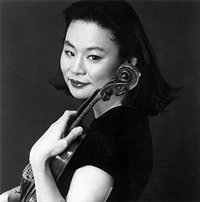S & H Concert Review
Beethoven, Mozart, Elgar; Midori (violin) London Symphony Orchestra, Zubin Mehta, Barbican Centre, 27th April, 2003 (AR)
An accomplished performance of Beethovenís Leonore No. 3 Overture opened Zubin Mehtaís LSO concert. Securing polished playing from the London Symphony Orchestra, notably some quite outstanding woodwind playing, the performance was given added edge with the incisive interplay between violins and Ďcellos and the off stage trumpet call. However, what was lacking was a sense of urgency and tension in the final passages, with the horns too toned down and the final timpani roll lacking proper weight and attack.Mozartís Violin Concerto No.3 in G Major K 218 was given sensitive and refined support from Mehta and a reduced LSO Ė but what let the performance down was the florid playing of Midori. Her playing of the Allegro was brittle, harsh and heavy making the music sound too often as if it had come from the 19th century. When we got to the Adagio things got sadly worse with Midoriís playing becoming almost schizoid: in the quieter passages she would melt into an opaque nothingness breaking the line of the music, then suddenly change pace and play far too loudly. She seemed to be aiming for a very wide dynamic range but the result was wayward and inchoate.
She rushed her way through the Rondeau at a tremendous pace producing both a scratchy and sour sound. While it is essential to perform Mozart with vigour, Midori confuses attack with anarchy: at times the sounds she produced were shrill. Some of the most exquisite music Mozart created sounded strident and brash in Midoriís hands. Anne Sophie-Mutterís legendary 1978 performance under Herbert von Karajan and the Berlin Philharmonic Orchestra is far more in tune with what Mozart intended with it purity of tone and classical discipline. (DG 415 327-2).
In complete contrast, Midoriís full-blooded playing of Elgarís Violin Concerto produced from her some of the best violin playing I have heard.
Midoriís animal energy is better suited to Elgarís emotional landscape: rugged, diverse and impassioned. Mehta opened this symphonic-type concerto with great panache and drive securing extraordinarily beautiful playing from the LSO, specially from the horns.
With the Andante. Midoriís playing was exquisitely pliant, sounding radiant and delicate: one could hardly believe this was the same violinist who had been so disappointing in the first half. The finale began with the soloist in total command of her dazzling technique, and Mehta drawing intensely impassioned playing from the LSO.
In the middle of the movement comes one of Elgarís most inspired pieces of writing: a demanding and lengthy accompanied cadenza which is both the core and structural climax of the work. Here the strings are instructed that the pizzicato tremolando should be thrummed with the soft part of three fingers whilst the violin plays over themes reprised from the earlier movements. Accompanying Midoriís fragile and floating phrases, Mehta got the strings to create an eerie fluttering sound. Her playing of the cadenza itself was radiant and inspired, holding the entire hall totally in awe. Mehta marched his forces to a gloriously powerful conclusion which had the audience in raptures.
Mehta proved himself to be a superb exponent of Elgar and should certainly record this work with Midori, with whom he has already made several fine recordings, and the LSO who responded so magnificently to his baton.
Alex Russell
